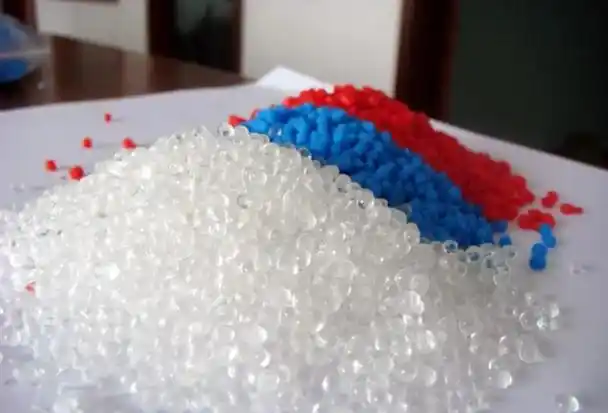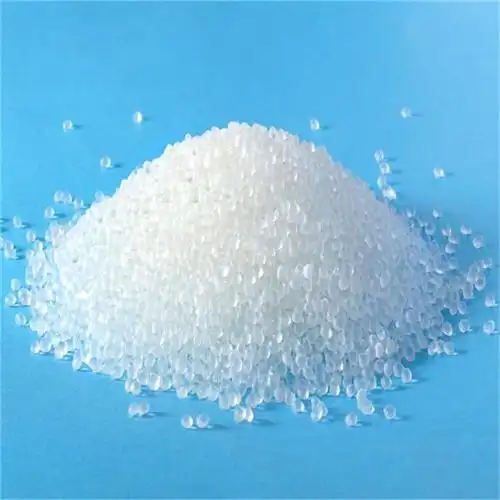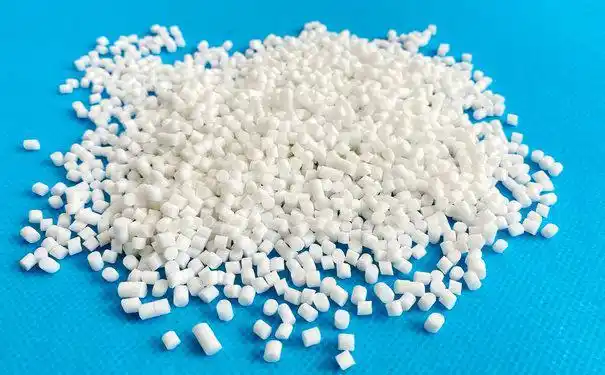Having spent over a decade in the polymer industry, particularly working with thermoplastic elastomers (TPEs) in applications like cast films, I’ve seen my fair share of material quirks. One issue that frequently comes up, especially among manufacturers and quality control teams, is the appearance of white crystal points in TPE cast films. These tiny, often frustrating specks can compromise the aesthetics, performance, and reliability of the final product. If you’re dealing with this issue, you’re likely wondering what causes these white spots and how to fix them. Let’s dive into the problem, explore its root causes, and share practical solutions based on my experience to help you produce flawless TPE films.

What Are White Crystal Points in TPE Cast Films?
Before we get into the causes, let’s clarify what we mean by white crystal points. These are small, white, or translucent specks that appear on the surface or within the matrix of TPE cast films. They’re often visible to the naked eye and can range from pinhead-sized dots to slightly larger inclusions. In my work with TPE films for packaging and medical applications, I’ve seen these points cause rejections in quality checks due to their impact on appearance, clarity, or even mechanical properties.
The presence of white crystal points can be particularly problematic in applications where transparency or uniformity is critical, such as food packaging or medical films. Understanding why they form is the first step to eliminating them.
Common Causes of White Crystal Points
From my years of troubleshooting TPE-related issues, I’ve identified several key factors that contribute to white crystal points in cast films. Let’s break them down:
Undispersed Additives or Fillers: TPEs are complex blends of polymers, plasticizers, fillers (like calcium carbonate or talc), and additives (like stabilizers or colorants). If these components aren’t properly mixed during compounding, they can form agglomerates—tiny clumps that appear as white crystal points in the final film.
Crystallization of Polymer Chains: Some TPEs, particularly those with semi-crystalline components like styrene-ethylene-butylene-styrene (SEBS) or polypropylene-based blends, can develop crystalline regions during processing. These regions scatter light, creating the appearance of white specks.
Contamination: Contamination is a common culprit in my experience. This can come from foreign particles, dust, or even cross-contamination from other materials in the production line. For example, I once traced white points in a TPE film to residual polyethylene from a poorly cleaned extruder.
Moisture in Raw Materials: TPEs are hygroscopic, meaning they can absorb moisture from the environment. If the TPE pellets aren’t properly dried before processing, moisture can vaporize during extrusion, leaving voids or crystalline defects that look like white points.
Incompatible Additives: Sometimes, the additives used in TPE formulations—like lubricants or slip agents—aren’t fully compatible with the polymer matrix. This can lead to phase separation, where additives migrate and form visible specks.
Processing Conditions: Improper extrusion parameters, such as incorrect temperature profiles or inadequate shear mixing, can prevent proper dispersion of components, leading to white crystal points. I’ve seen this happen when manufacturers push for higher throughput without optimizing their extruder settings.

To summarize these causes, here’s a table I’ve put together based on my observations:
|
Cause |
Impact on Film |
Common Source |
Solution |
|---|---|---|---|
|
Undispersed Additives |
Visible white specks, uneven texture |
Poor compounding or mixing |
Improve compounding; use high-shear mixers |
|
Polymer Crystallization |
Translucent or white spots |
Semi-crystalline TPE components |
Adjust cooling rates; use amorphous TPEs |
|
Contamination |
Random specks, inconsistent appearance |
Dirty equipment or raw materials |
Clean extruders; use filtered materials |
|
Moisture in Raw Materials |
Voids or crystalline defects |
Improper drying of TPE pellets |
Dry pellets thoroughly before extrusion |
Real-World Troubleshooting: A Case Study
Let me share a story from a project I worked on a few years ago. A client producing TPE cast films for food packaging was struggling with white crystal points that kept failing their quality inspections. The specks were small but noticeable, and customers were complaining about the film’s appearance. After visiting their facility, I noticed their TPE pellets were stored in an open warehouse with high humidity. We ran tests and confirmed moisture levels in the pellets were above the recommended threshold.
We implemented a rigorous drying protocol, using a desiccant dryer to bring the moisture content below 0.02%. Additionally, we adjusted the extruder’s temperature profile to ensure better melting and dispersion of additives. Within a week, the white crystal points were gone, and the client’s rejection rate dropped to near zero. This experience taught me the importance of addressing both material handling and processing conditions to tackle this issue.

How to Prevent White Crystal Points
Based on my hands-on experience, here are actionable steps to prevent white crystal points in TPE cast films:
Optimize Compounding: Work closely with your TPE supplier to ensure the formulation is well-mixed. High-shear compounding equipment can help disperse additives and fillers evenly, reducing the risk of agglomerates.
Dry Raw Materials Thoroughly: Always dry TPE pellets before extrusion, ideally to a moisture content below 0.02%. Use a desiccant dryer and store pellets in a controlled environment to prevent moisture absorption.
Clean Equipment Regularly: Contamination is a silent killer in film production. Clean your extruder, dies, and feed systems regularly to avoid cross-contamination from other materials. I recommend using purging compounds for thorough cleaning between runs.
Adjust Processing Parameters: Fine-tune your extrusion settings, including temperature, screw speed, and cooling rates. For example, too-rapid cooling can induce crystallization in some TPEs, so experiment with slower cooling to maintain uniformity.
Choose the Right TPE Grade: Not all TPEs are suited for cast film applications. Opt for grades specifically designed for films, which often have lower crystallinity and better additive compatibility. Ask your supplier for technical data sheets and test samples.
Test for Compatibility: If you’re using additives like slip agents or colorants, ensure they’re compatible with your TPE. Run small-scale trials to check for phase separation or migration before full production.
Industry Standards and Testing
In my work with TPE films, I’ve relied on standards like ASTM D1238 (for melt flow rate) and ISO 1133 to assess material behavior during processing. These tests can help identify whether a TPE’s flow properties contribute to issues like undispersed additives. For quality control, optical microscopy or scanning electron microscopy (SEM) can be used to analyze white crystal points and determine their composition—whether they’re crystalline polymer regions, filler agglomerates, or contaminants.
If you’re producing films for sensitive applications like medical or food packaging, consider testing for extractables and leachables under standards like ISO 10993 or FDA 21 CFR. These tests ensure that no unwanted substances, including those causing white points, compromise the film’s safety or performance.

Practical Advice for Manufacturers
If you’re a manufacturer dealing with white crystal points, start by auditing your process. Check your raw material storage, drying procedures, and equipment cleanliness. Then, review your extrusion parameters—temperature, screw speed, and cooling rates. If the issue persists, collaborate with your TPE supplier to analyze the material. They can run tests like Fourier Transform Infrared Spectroscopy (FTIR) to identify whether the specks are due to additives, contaminants, or polymer crystallization.
For smaller operations without access to advanced testing, a practical approach is to run small-scale trials with different TPE grades or processing conditions. Document each trial to pinpoint what works. In one project, I helped a small manufacturer eliminate white points by switching to a TPE grade with a lower filler content and adjusting the extruder’s residence time.
Tips for End Users and Designers
If you’re not producing the films but specifying TPEs for a product, here’s what you can do to avoid issues with white crystal points:
Specify Film-Grade TPEs: When working with your supplier, request TPE grades optimized for cast film applications. These typically have better clarity and fewer defects.
Request Samples and Test: Before committing to a large order, test TPE film samples under your application’s conditions. Look for visual defects and check performance over time.
Communicate Requirements: Be clear about your needs—whether it’s transparency, flexibility, or regulatory compliance. This helps suppliers recommend the right TPE formulation.
The Bigger Picture: Quality vs. Cost
In my experience, white crystal points often stem from cutting corners—whether it’s using low-cost TPE grades, skipping drying steps, or neglecting equipment maintenance. While these choices might save money upfront, they can lead to costly rejections, customer complaints, or even product failures. Investing in high-quality TPEs and robust processing protocols pays off in the long run by ensuring consistent, defect-free films.
For example, in a medical film project, we initially considered a cheaper TPE to meet budget constraints. However, lab tests revealed white crystal points due to poor additive dispersion. Switching to a premium, film-grade TPE increased costs by 10% but eliminated defects and ensured compliance with regulatory standards. The client’s product passed audits with flying colors, proving the value of prioritizing quality.

Wrapping It Up: Solving the White Crystal Point Puzzle
Dealing with white crystal points in TPE cast films can feel like solving a puzzle, but with the right approach, it’s entirely manageable. By focusing on material quality, proper processing, and rigorous testing, you can produce films that are clear, uniform, and reliable. Whether you’re a manufacturer tweaking your extrusion line or a designer selecting materials, understanding the causes of white crystal points empowers you to make smart decisions.
If you’re grappling with this issue, don’t hesitate to reach out to your TPE supplier or a materials consultant. They can provide tailored advice and testing to get your films back on track. With a bit of effort and attention to detail, those pesky white specks can become a thing of the past.
Related Questions and Answers
Q: Can white crystal points affect the safety of TPE films?
A: In most cases, white crystal points are an aesthetic issue, but in sensitive applications like medical or food-contact films, they could indicate contamination or additive migration. Always test for compliance with standards like ISO 10993 or FDA 21 CFR.
Q: How do I know if the issue is due to moisture or additives?
A: Run a drying test—extrude a small batch after thoroughly drying the TPE pellets. If the points disappear, moisture is likely the culprit. If not, analyze the specks with microscopy or FTIR to check for additive agglomerates.
Q: Are all TPEs prone to white crystal points?
A: No, high-quality, film-grade TPEs with proper formulations and processing are less likely to show white points. Choosing the right grade and optimizing extrusion conditions can prevent the issue.
Q: Can I remove white crystal points after the film is made?
A: Unfortunately, white points are embedded in the film and can’t be removed post-production. Focus on preventing them through better material selection and processing.





